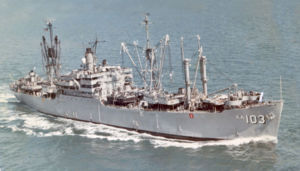Attack cargo ship
Attack cargo ships were WWII-era U.S. Navy ships designed specifically to carry troops, heavy equipment and supplies in support of amphibious assaults, and to provide naval gunfire support during those assaults. Their hull classification was AKA.
The biggest difference between these ships and other cargo ship types was their ability to carry and handle large numbers of landing craft. They were also faster, had more armament, and had larger hatches and booms. Their holds were optimized for combat loading, a method of cargo storage where the items first needed ashore were at the top of the hold, and those needed later were lower down. Because these ships went into into forward combat areas, they had Combat Information Centers and significant amounts of equipment for radio communication, neither of which were present in other cargo ships.
World War II
The need for ships of this type became apparent during World War II, when amphibious warfare doctrine underwent a period of rapid development as Japanese strongholds in the Pacific were invaded from the sea. Planners saw the need for a special kind of cargo ship—one that could carry both cargo and the LCM and LCVP boats with which to deliver it to the beach, and that carried guns to assist in air defense and shore bombardment. Specifications were drawn up, and beginning in early 1943, the first 16 U.S. Attack Cargo Ships were converted from Navy cargo ships that had previously been designated AK.
Six new AKAs were built during 1943, 41 during 1944, and 45 during 1946. A new attack cargo ship was commissioned an average of every nine days during the latter two years. Construction stopped at the end of the war, 108 AKAs having been built or converted during its duration.
Attack cargo ships played a vital role in the Pacific War, where many were attacked by kamikazes and other aircraft, and several were torpedoed, but none were sunk or otherwise destroyed. Nine AKA's were present at the surrender ceremony in Tokyo Bay on 2 September 1945:
- USS Libra (AKA-12)
- USS Medea (AKA-31)
- USS Pamina (AKA-34)
- USS Sirona (AKA-43)
- USS Skagit (AKA-105)
- USS Todd (AKA-71)
- USS Tolland (AKA-64)
- USS Whiteside (AKA-90)
- USS Yancey (AKA-93)
Postwar period
Within a year of the war's end, 70 of the 108 AKAs had been decommissioned and either sold or put into the National Defense Reserve Fleet. Eight others were converted to ships of different types such as ammunition ships, oceanographic survey ships, repair ships, or cable layers.
Ten of the reserve ships were recommissioned for service in the Korean War. One AKA, USS Tulare (AKA-112), somewhat larger than the others, was built and commissioned in 1954. She and some of the WWII AKAs saw service in Vietnam. Several of the AKAs, most notably USS Arneb (AKA-53), saw service in establishing and maintaining U.S. bases in Antarctica.
Five more amphibious cargo ships, much larger and of a completely new design, were built between 1968 and 1970.
In 1969, the U.S. Navy redesignated all its AKA attack cargo ships as LKA amphibious cargo ships. At the same time, the other "A" designations of amphibious ships were changed to similar "L" designations. For example, the all the APAs were redesignated as LPAs. The remaining WWII AKA/LKAs were decommissioned shortly thereafter, the last one finally being taken from service in 1971.
In the mid 1990s, both the United States Navy and the Royal Navy developed amphibious transport docks which took on this unique amphibious role. The last amphibious cargo ship in the U. S. Navy, USS El Paso (LKA-117), was decommissioned in April, 1994.
See also
- Andromeda-class attack cargo ship
- Arcturus-class attack cargo ship
- Artemis-class attack cargo ship
- Charleston-class amphibious cargo ship
- Tolland-class attack cargo ship
- List of attack cargo ships of the United States Navy (AKA)
- List of amphibious cargo ships of the United States Navy (LKA)
- Attack transport (APA/LPA). Nearly identical ships used to tranport troops and landing craft.
References
- Alexander, Joseph H. Storm Landings: Epic Amphibious Battles in the Central Pacific. 1997. Annapolis, Maryland: Naval Institute Press. ISBN 1-55750-032-0
- Crew, Thomas E. Combat Loaded: Across the Pacific on the USS Tate. 2007. College Station, Texas: Texas A&M University Press. ISBN 1-58544-556-8
- Dodson, Kenneth. Away all Boats. 1954. Boston: Little Brown and Company
- Friedman, Norman. U.S. Amphibious Ships and Craft: An Illustrated Design History. 2002. Annapolis, Maryland: Naval Institute Press. ISBN 1-55750-250-1
- Heggen, Thomas. Mister Roberts. 1946. Boston: Houghton Mifflin Company. ISBN 0-395-07788-5
- Lane, Frederic C. Ships for Victory: A History of Shipbuilding under the U.S. Maritime Commission in World War II. 1951, 2001. Baltimore, Maryland: The Johns Hopkins University Press. ISBN 0-8018-6752-5
- Linner, John H. MD. From Normandy to Okinawa: A Navy Medical Officer's Diary and Overview of World War II. 2000. Edina, Minnesota: Malibu-DelRay Publishing Company. ISBN 0-9703-2430-8
- North Carolina Shipbuilding Company. Five Years of North Carolina Shipbuilding. 1946. Wilmington, North Carolina: North Carolina Shipbuilding Company.
